DREAMBOX DM 500 HD User Manual
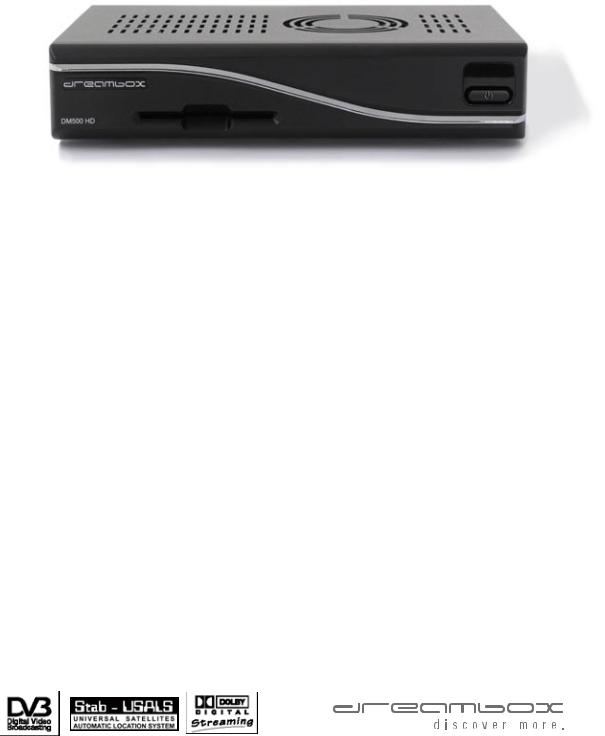
-1-
DREAMBOX
DM500 HD
Instruction manual
Digital satellite receiver for free and encrypted Digital
Video Broadcasting (DVB).
HDTV
Ethernet-Port
DVB-S2 Tuner
Smartcard Reader
Linux OS
-2-
Table of contents
1. Before initial operation of the receiver.......... |
4 |
|
1.1 |
Safety instructions................................ |
4 |
1.2 |
Packaging contents............................... |
6 |
1.3 |
Views................................................... |
7 |
|
1.3.1 Explanation Front Panel............... |
8 |
|
1.3.2 Explanation rear panel................. |
8 |
1.4 |
Remote control..................................... |
9 |
2. Installation................................................ |
13 |
|
2.1 |
Turning the device on............................ |
13 |
3. Start wizard............................................... |
14 |
|
3.1 |
Video output selection........................... |
14 |
3.2 |
Language selection............................... |
15 |
3.3 |
Tuner setup.......................................... |
16 |
3.4 |
Default services list/Service scan............ |
16 |
3.5 |
Parental Control................................... |
16 |
3.6 |
Network............................................... |
17 |
4. Basic operation.......................................... |
19 |
|
4.1 |
Turning your Dreambox on and off.......... |
19 |
4.2 |
Service selection.................................. |
20 |
4.3 |
Changing channel using the service list... |
20 |
4.4 |
Controlling the volume.......................... |
20 |
4.5 |
Changing the audio track....................... |
21 |
4.6 |
Sub Services........................................ |
21 |
4.7 |
TV/Radio switching............................... |
21 |
4.8 |
Teletext................................................ |
21 |
4.9 |
Subtitles............................................. |
21 |
4.10 Infobar............................................... |
22 |
|
5. Electronic Program Guide - EPG.................. |
22 |
|
5.1 |
Single-EPG.......................................... |
23 |
5.2 |
Multi-EPG............................................ |
23 |
5.3 |
Graphical Multi-EPG............................. |
24 |
|
6. Edit the channellist.................................... |
25 |
||
6.1 |
Adding a bouquet................................. |
26 |
|
6.2 |
Add a service to favorites....................... |
27 |
|
6.3 |
Adding multiple services to a bouquet.... |
27 |
|
6.4 |
Remove a service from favorites............. |
28 |
|
6.5 |
Moving a service to favorites.................. |
29 |
|
6.6 |
Adding a marker to favorites.................. |
30 |
|
6.7 |
Parental control.................................... |
31 |
|
7. External eSATA Hard Disk........................... |
34 |
||
7.1 |
Management........................................ |
34 |
|
|
7.1.1 Initialization............................... |
34 |
|
7.2 |
Recording............................................ |
35 |
|
|
7.2.1 Instant recording........................ |
35 |
|
|
7.2.2 Stop recording............................ |
36 |
|
|
7.2.3 Recording by timer...................... |
36 |
|
|
7.2.4 Time shift................................... |
38 |
|
7.3 |
Watch a recording................................. |
38 |
|
7.4 |
Setting a marker (Bookmarks)................ |
40 |
|
7.5 |
Delete a recording................................ |
41 |
|
7.6 |
Movielist options.................................. |
41 |
|
8. Teletext..................................................... |
43 |
||
9. Sleep timer................................................ |
44 |
||
10. Setup...................................................... |
45 |
||
10.1 |
Language........................................... |
45 |
|
10.2 |
Customize.......................................... |
46 |
|
10.3 |
Setting the time zone.......................... |
47 |
|
10.4 |
A/V Settings....................................... |
48 |
|
10.5 |
Network............................................. |
50 |
|
10.6 |
Skin.................................................. |
52 |
|
10.7 |
Factory reset...................................... |
52 |
|
-3-
11. |
Service searching..................................... |
53 |
|
|
11.1 |
DVB-S2 Tuner configuration................. |
53 |
|
11.1.1 Single satellite – direct |
|
|
|
|
connection................................... |
53 |
|
11.1.2 Two satellites via Toneburst |
|
|
|
|
A/B............................................... |
54 |
|
11.1.3 Two satellites via DiSEqC |
|
|
|
|
A/B.............................................. |
54 |
|
11.1.4 Four satellites via DiSEqC |
|
|
|
|
A/B/C/D........................................ |
55 |
|
11.1.5 Stab Positioner using USALS |
|
|
|
|
................................................... |
56 |
|
11.1.6 Stab Positioner without USALS |
|
|
|
|
................................................... |
56 |
|
11.2 |
Automatic scan.................................. |
57 |
|
11.3 |
Manual scan...................................... |
58 |
12. |
Systeminformation................................... |
59 |
|
|
12.1 |
Service.............................................. |
59 |
|
12.2 |
About (Hardand Software)................. |
59 |
13. |
Installing new software............................. |
60 |
|
14. |
Troubleshooting........................................ |
63 |
|
15. |
TV-Mode setup......................................... |
63 |
|
|
15.1 |
Programming the remote control.......... |
64 |
16. |
Technical data......................................... |
64 |
|
17. |
Contact & support information................... |
66 |
|
18. |
Copyright notes........................................ |
67 |
|
|
18.1 |
GNU GENERAL PUBLIC LICENSE....... |
68 |
The Dreambox DM500 HD carries the CE-Sign and fulfills all requirements from the EU.
Subject to change without prior notification.
DiSEqCTM is a registered trademark of EUTELSAT.
Dolby and the Double-D-Symbol are registered trademarks of Dolby Laboratories.
HDMI is a registered trademark of HDMI Licensing, LLC.
19. Service Slip............................................. |
71 |

-4-
1. Before initial operation of the receiver
1.1 Safety instructions
Please read the safety instructions completely and carefully, before using the Dreambox.
The Manufacturer takes no responsibility for damages as a result of incorrect handling of the Dreambox.
•Allow enough space around the Dreambox for sufficient ventilation.
•Do not cover the top of the Dreambox and allow enough space to other devices. The louvers of the devices must be free at all times to allow sufficient heat transfer from inside the device.
•Never put vases or any other liquid filled containers on top of the device. Do not expose the device to dripping or splashing liquids.
•Do not place open flame sources, such as lit candles, on top of the device.
•The device may only be operated in moderate climate.
•Do not remove the cover. Risk of electric shock. If it is necessary to open the device please contact a trained professional.
•Do not put any metal things into the slots or ventilation openings.
Shut down
•In case your Dreambox is in use for a longer period of time disconnect the power plug from the power outlet.
•During thunder storm the unit should also be physically disconnected from the power outlet.
Additional safety instructions
•(Dis-)Connecting to a LNB:
Turn the Dreambox off before you connect or disconnect a cable coming from or going to a LNB.
•Connecting to a TV:
Before connecting or disconnecting your Dreambox to/from a TV please turn it off.
•In case you notice any damage to the power cord or power plug immediately disconnect the device from the power outlet.
•In case the device was exposed to humidity immediately disconnect the device from the power outlet.
•In case you notice any serious damage to the outer shell of the device immediately disconnect the device from the power outlet.
•Do not expose the Dreambox to direct sunlight, lightning or rain.

-5-
•Grounding:
The LNB cable must be grounded.
The grounding system must meet SABS 061 requirements.
•Cleaning:
Disconnect the mains power cord before cleaning the cover. Use a slightly damp cloth without cleaning agents.
•Connect the Dreambox only to suitable sockets. Do not allow overloads to occur.
•Please be careful that the batteries of your remote control are not exposed to heat, since they might explode.
Disposal instructions
The packaging of the Dreambox only consists of reusable materials. Please recycle if possible.
This symbol on the product or on its packaging indicates that this product must not be disposed of with your other household waste. Instead, it is your responsibility to dispose of your waste equipment by handing it over to a designated collection point for the recycling of waste electrical and electronic equipment. The separate collection and recycling of your waste equipment at the time of disposal will help to conserve natural resources and ensure that it is recycled in a manner that protects human health and the environment.
For more information about where you can drop off your waste equipment for recycling, please contact your local city office, your household waste disposal service or the shop where you purchased the product.
Please note that empty batteries and electric waste is not to be put into the regular garbage.
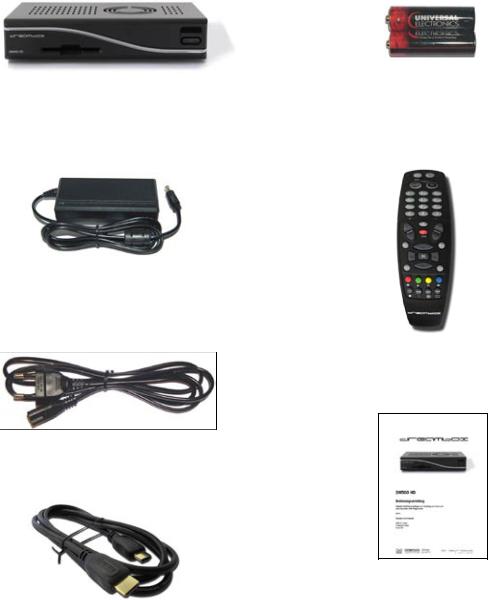
-6-
1.2 Packaging contents
Please check the completeness of the box’s contents.
Included in box:
Dreambox DM500 HD
Power supply
Power Cord
HDMI cable
2 Batteries
(1,5V Mignon / AA / LR6)
Remote control
Quickguide
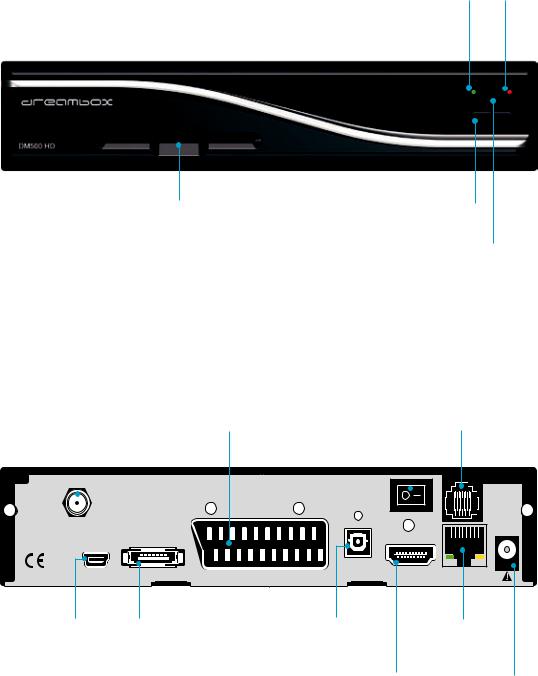
-7-
1.3 Views
Front view
Standby-LEDs
Smartcard Reader |
Standby-Button |
|
Remote control sensor
Rear view
|
|
|
Power switch |
|||
LNB-In |
TV-Scart |
|
|
|
Modem |
|
|
|
|
||||
out |
|
|
|
port |
||
|
|
|
|
|
||
|
|
|||||
|
|
|
|
|
|
|
|
|
|
|
|
|
|
|
|
|
|
|
|
|
|
|
Scart TV |
|
Modem |
|
|
|
|
|
LNB IN |
|
|
|
DC 12V |
|
|
|
|
|
SERVICE |
eSATA |
Digital |
|
|
Audio |
HDMI |
Ethernet |
Service |
eSATA |
Digital |
Network |
port |
connector |
audio out |
interface |
|
|
HDMI |
Power |
|
|
out |
connector |
-8-
1.3.1 Explanation Front Panel
Smartcard reader
Insert your Dreamcrypt Smartcard with the golden chip facing down and forward into one of the two Smartcard reader slots. Dreamcrypt is a registered trademark of Dream-Multimedia.
Standby-LEDs
One red and one green LED show the standby status of your Dreambox.
Remote control sensor
The remote control sensor receives the infrared signals of the Dream Remote Control.
Standby-Button
The Standby-Button switches your Dreambox on and off.
1.3.2 Explanation rear panel
LNB-Input (DVB-S2 Tuner)
Connect the coaxial cable from your LNB here.
Service port
The mini-USB Service port is used to update the operating system and to pre-programm you Dreambox using a PC.
TV Scart output
Connect your TV, projector or beamer to your Dreambox using a Scart cable.
eSATA connector
You can connect an external eSATA Hard disk.
Digital audio out (Toslink)
You can connect your Dreambox with an optical (Toslink) cable to your HiFi-Amplifier or DSP. The AC3 signal is also available at this port in case the selected channel transmits Dolby Digital signals.
HDMI output
Use the HDMI cable to connect the HDMI output to the HDMI input of your TV.
Power Switch
The power switch is used to cut all power from your Dreambox.
Network interface
The 10/100Mbit Ethternet port is used to communicate with your Dreambox via HTTP, FTP, NFS, Telnet, SSH and Samba. This port is also used to update the operating system of your Dreambox. Please use a regular patch cable to connect your Dreambox to your LAN.
Modem port
The modem port can be used to establish an internet connection using a analog phone line.
Power supply connector
Plug the power cable of the power supply that came with your Dreambox into power outlet. Connect your power supply to your Dreambox. You must not connect the power plug of the power supply to anything other than a socket that supplies 110V/60Hz or 230V/50Hz.

|
|
|
|
|
|
|
|
|
|
|
|
|
|
|
|
|
|
|
|
|
|
-9- |
|
|
|
|
|
|
|
|
|
|
|
|
|
|
|
|
|
|
|
||||||
1.4 Remote control |
|
|
|
|
|
|
|
|
|
|
|
|
|
|
|
|
|
|
|
|
|
|
|
|
|
|
|||||||||||||||||||||
|
|
|
|
|
|
|
|
|
|
|
|
|
|
|
|
|
|
|
|
|
|
|
|
|
|
|
|
|
|
|
|
|
|
|
|
|
|
|
|
|
|
|
|
|
|
|
|
|
SHIFT / SETUP-Button |
|
|
|
|
|
|
|
|
|
|
|
|
|
|
|
|
|
|
|
|
|
|
|
Power-Button |
|
|
|
|
||||||||||||||||||
|
|
|
|
|
|
|
|
|
|
|
|
|
|
|
|
|
|
|
|
|
|
|
|
|
|
|
|
||||||||||||||||||||
|
|
|
|
|
|
|
|
|
|
|
|
|
|
|
|
|
|
|
|
|
|
|
|
|
|
|
|
|
|
|
|
|
|
|
|
|
|
|
|
|
|
|
|
|
|
|
|
|
DREAM-Mode-Button |
|
|
|
|
|
|
|
|
|
|
|
|
|
|
|
|
|
|
|
|
|
|
|
|
|
|
|
|
|
|
|
|
||||||||||||||
|
|
|
|
|
|
|
|
|
|
|
|
|
|
|
|
|
|
TV-Mode-Button |
|
|
|||||||||||||||||||||||||||
|
|
|
|
|
|
|
|
|
|
|
|
|
|
|
|
|
|
|
|
|
|
|
|
|
|
|
|||||||||||||||||||||
|
|
|
|
|
|
|
|
|
|
|
|
|
|
|
|
|
|
|
|
|
|
|
|
|
|
|
|||||||||||||||||||||
|
|
|
|
|
|
|
|
|
|
|
|
|
|
|
|
|
|
|
|
|
|
|
|
|
|
|
|
|
|
|
|
|
|
|
|
|
|
|
|
|
|
||||||
|
|
|
|
|
|
|
|
|
|
|
|
|
|
|
|
|
|
|
|
|
|
|
|
|
|
|
|
|
|
|
|
|
|
|
|
|
|
|
|
|
|
|
|
|
|
|
|
|
|
|
|
|
|
|
|
|
|
|
|
|
|
|
|
|
|
|
|
|
|
|
|
|
|
|
|
|
|
|
|
|
|
|
|
|
|
|
|
|
|
|
|
|
|
|
|
|
Numeric-Keypad |
|
|
|
|
|
|
|
|
|
|
|
|
|
|
|
|
|
|
|
|
|
|
|
|
|
|
|
|
|
|
|
|
|
|
|
|
|
|||||||||
|
|
|
|
|
|
|
|
|
|
|
|
|
|
|
|
|
|
|
|
|
|
|
|
|
|
|
|
|
|
|
|
|
|
|
|
|
|
||||||||||
|
|
|
|
|
|
|
|
|
|
|
|
|
|
|
|
|
|
|
|
|
|
|
|
|
|
|
|
|
|
|
|
|
|
|
|
|
|
|
|
|
|
|
|
|
|
|
|
|
Arrow-Left-Button |
|
|
|
|
|
|
|
|
|
|
|
|
|
|
|
|
|
|
|
|
|
|
|
|
|
|
|
|
Arrow-Right-Button |
|
||||||||||||||||
|
|
|
|
|
|
|
|
|
|
|
|
|
|
|
|
|
|
|
|
|
|
|
|
|
|
|
|
|
|
||||||||||||||||||
|
|
|
|
|
|
|
|
|
|
|
|
|
|
|
|
|
|
|
|
|
|
|
|
|
|
|
|
|
|
|
|
|
|
|
|
|
|
|
|
|
|
|
|
|
|
|
|
|
Mute-Button |
|
|
|
|
|
|
|
|
|
|
|
|
|
|
|
|
|
|
|
|
|
|
|
|
|
|
|
|
|
|
|
|
|
EXIT-Button |
|
|
|
|
|
|
||||||
|
|
|
|
|
|
|
|
|
|
|
|
|
|
|
|
|
|
|
|
|
|
|
|
|
|
|
|
|
|
|
|
|
|
|
|
|
|
|
|
|
|
|
|||||
|
Volume +/- Buttons |
|
|
|
|
|
|
|
|
|
|
|
|
|
|
|
|
|
|
|
|
|
|
|
|
|
|
Bouquet +/- Buttons |
|||||||||||||||||||
|
|
|
|
|
|
|
|
|
|
|
|
|
|
|
|
|
|
|
|
|
|
|
|
|
|
|
|||||||||||||||||||||
|
|
|
|
|
|
|
|
|
|
|
|
|
|
|
|
|
|
|
|
|
|
|
|
|
|
|
|
|
|
|
|
|
|
|
|
|
|
|
|
|
|
||||||
|
Info-Button |
|
|
|
|
|
|
|
|
|
|
|
|
|
|
|
|
|
|
|
|
|
|
|
|
|
|
|
|
|
|
|
|
|
MENU-Button |
|
|
|
|||||||||
|
|
|
|
|
|
|
|
|
|
|
|
|
|
|
|
|
|
|
|
|
|
|
|
|
|
|
|
|
|
|
|
|
|
|
|
|
|
|
|
||||||||
|
|
|
|
|
|
|
|
|
|
|
|
|
|
|
|
|
|
|
|
|
|
|
|
|
|
|
|
|
|
|
|
|
|
|
|
|
|
|
|
||||||||
|
|
|
|
|
|
|
|
|
|
|
|
|
|
|
|
|
|
|
|
|
|
|
|
|
|
|
|
|
|
|
|
|
|
|
|
|
|
|
|
|
|
|
|
|
|||
|
Navigation-Buttons |
|
|
|
|
|
|
|
|
|
|
|
|
|
|
|
|
|
|
|
|
|
|
|
|
|
|
OK-Button |
|
|
|
|
|
|
|
||||||||||||
|
|
|
|
|
|
|
|
|
|
|
|
|
|
|
|
|
|
|
|
|
|
|
|
|
|
|
|
|
|
|
|
|
|
||||||||||||||
|
|
|
|
|
|
|
|
|
|
|
|
|
|
|
|
|
|
|
|
|
|
|
|
|
|
|
|
|
|
|
|
|
|
|
|
|
|
|
|
|
|
|
|
||||
|
AUDIO-Button |
|
|
|
|
|
|
|
|
|
|
|
|
|
|
|
|
|
|
|
|
|
|
|
|
|
|
|
|
|
|
|
|
|
|
|
|
|
|
||||||||
|
|
|
|
|
|
|
|
|
|
|
|
|
|
|
|
|
|
VIDEO-Button |
|
|
|
|
|||||||||||||||||||||||||
|
|
|
|
|
|
|
|
|
|
|
|
|
|
|
|
|
|
|
|
|
|
|
|
|
|
|
|
|
|
|
|
|
|
|
|
|
|||||||||||
|
|
|
|
|
|
|
|
|
|
|
|
|
|
|
|
|
|
|
|
|
|
|
|
|
|
|
|
|
|
|
|
|
|
|
|
|
|||||||||||
|
|
|
|
|
|
|
|
|
|
|
|
|
|
|
|
|
|
|
|
|
|
|
|
|
|
|
|
|
|
|
|
|
|
|
|
|
|
|
|
|
|
|
|||||
|
Options-Buttons |
|
|
|
|
|
|
|
|
|
|
|
|
|
|
|
|
|
|
|
|
|
|
|
|
|
|
|
|
|
|
|
|
|
|
|
|
|
|
||||||||
|
|
|
|
|
|
|
|
|
|
|
|
|
|
|
|
|
|
|
|
|
|
|
|
|
|
|
|
|
|
|
|
|
|
|
|
|
|
|
|||||||||
|
|
|
|
|
|
|
|
|
|
|
|
|
|
|
|
|
|
|
|
|
|
|
|
|
|
|
|
|
|
|
|
|
|
|
|
|
|
|
|||||||||
|
|
|
|
|
|
|
|
|
|
|
|
|
|
|
|
|
|
|
|
|
|
|
|
|
|
|
|
|
|
|
|
|
|
|
|
||||||||||||
|
TV-Button |
|
|
|
|
|
|
|
|
|
|
|
|
|
|
|
|
|
|
|
|
|
|
|
|
|
|
|
|
|
|
|
|
|
|
|
|
|
|
HELP-Button |
|
||||||
|
|
|
|
|
|
|
|
|
|
|
|
|
|
|
|
|
|
|
|
|
|
|
|
|
|
|
|
|
|
|
|
|
|
|
|
|
|
|
|
|
|
|
|||||
|
|
|
|
|
|
|
|
|
|
|
|
|
|
|
|
|
|
|
|
|
|
|
|
|
|
|
|
|
|
|
|
|
|
|
|
|
|
|
|
|
|
|
|
|
|
|
|
|
|
|
|
|
|
|
|
|
|
|
|
|
|
|
|
|
|
|
|
|
|
|
|
|
|
|
|
|
|
|
|
|
|
|
|
|
|
|
|
TEXT-Button |
|
|
|
|
|
||
|
RADIO-Button |
|
|
|
|
|
|
|
|
|
|
|
|
|
|
|
|
|
|
|
|
|
|
|
|
|
|
|
|
|
|
|
|
|
|
|
|
|
|
||||||||
|
|
|
|
|
|
|
|
|
|
|
|
|
|
|
|
|
|
|
|
|
|
|
|
|
|
|
|
|
|
|
|
|
|
|
|
|
|
||||||||||
Important notes about operation
All functions of the Dreambox can be controlled via OSD-Menu (On-Screen-Display). This makes the handling of the Dreambox very easy for you. All options are indicated by four colored dots or beams (red, green, yellow, blue) in the OSD-Menu and can be started with the Option-Buttons on the Remote Control.
Depending on the chosen Menu, these options do vary.

-10-
All Menus and Service lists are closed with the EXIT-Button.
Navigation-Buttons
In general the menus are controlled using the
Navigation-Buttons on your remote control.
To get into a submenu you have to press the
OK-Button.
Explanation remote control buttons
SHIFT / SETUP-Button
The SHIFT/ SETUP-Button is used to preprogram the remote control to operate a TV. See chapter 15. TV-Mode setup.
Power-Button
The Power-Button switches your Dreambox on and off.
See chapter 4.1 Turning your Dreambox on and off.
DREAM-Mode-Button
The DREAM-Mode-Button switches your remote control into Dreambox control mode. It will shortly light up once your press the button.
TV-Mode-Button
The TV-Mode-Button switches your remote control into TV control mode to control your preprogrammed TV. It will shortly light up once your press the button.
See chapter 15. TV-Mode setup.

-11-
Numeric-Keypad
Enter a service number to directly access the option by using the Numeric Keypad. The service numbers are on the left side of the service list.
The Numeric Keypad can also be used to enter the teletext page number when you are in TV-Control-Mode and if your TV is teletext capable. The TV station has to submit teletext information; otherwise this feature cannot be used.
Arrow-Left-Button Arrow-Right-Button
The Arrow-Left and Arrow-Right-Button enable you to jump back and forth between the last 20 channels you have watched. If you have selected a sub service (see chapter 4.6) you can use these buttons to switch to the next sub service. Additionally these buttons can be used to delete characters during text input.
Mute-Button
Pressing the MUTE-Button mutes the Volume. A crossed speaker symbol will appear on the TV screen. Pressing it again or pressing one of the Volume +/- Buttons brings back the audio.
The Mute-Button deletes a character during text input.
EXIT-Button
You can leave all menus and service lists by pressing the EXIT-Button.
Volume +/- Buttons
The Volume +/- Buttons control the volume of the audio. Pressing + will make turn it up and pressing - will turn it down.
Bouquet +/- Buttons
Pressing the Bouquet +/- Buttons will jump back and forth between the bouquets.
INFO-Button
If no OSD menu is visible on the screen and you are in TV or RADIO-Mode, pressing the INFO-Button will reveal the EPG information of the chose channel if it is available.
Navigation-Buttons
In general the menus are controlled using the Navigation-Buttons on your remote control. To get into a submenu you have to press the OK-Button.

-12-
OK-Button
By pressing the OK-Button you confirm a selection in the menu or service list navigation.
If no OSD menu is present on your screen, the infobar is shown once you press the OK-Button.
MENU-Button
If you are in TVor RADIO-Mode, pressing this button will bring up the OSD main menu. The
OSD main menu has the following options:
You can switch to the needed option by pressing the
Navigation-Buttons up or down.
If you are in the service list, pressing the MENUButton brings up the service menu. The shown options may vary depending on the service list you selected.
AUDIO-Button
By pressing the AUDIO-Taste you can choose different audio tracks offered by the station.
Options-Buttons
All possible options are shown by the four colored dots/blocks (red, green, yellow, blue) and can be activated by the Options-Buttons.
Depending on the menu you currently are in the options will change and will be named differently.
TV-Button
Pressing the TV-Button activates the TV-Mode.
HELP-Button
Pressing the Help-Button activates the Help-Mode.
RADIO-Button
Pressing the RADIO-Button activates the RADIO-Mode.
TEXT-Button
The TEXT-Button activates the Teletext.
-13-
2.Installation
2.1 Turning the device on
•Place the batteries inside the battery compartment of the remote control keeping in mind the right polarity.
•Before using the Dreambox, please read the safety instructions (See chapter 1.1 Safety instructions)
•Connect the LNB or antenna with a coaxial cable to LNB in at your Dreambox.
See chapter 1.3.2 Explanation rear panel.
•Connect the Dreambox to your TV using a HDMIor Scart-cable.
•Plug in the power cable into the power supply and into a 110V/60Hz or 230V/50Hz power socket. Con nect the power supply with your Dreambox.
•If you are using a switchable power socket please shutdown your Dreambox into deep standby before switching off the power socket. See chapter 4.1 Turning your Dreambox on and off.
•If you switch on your Dreambox for the first time, you will see the setup wizard.
The setup wizard will guide you through the first time installation. Follow the instructions on the screen. See chapter 3. Start wizard.
•Please note that the factory setting for the video format is CVBS (FBAS).
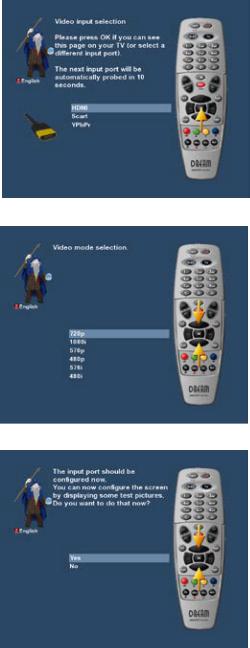
-14-
3.Start wizard
The start wizard helps you with the basic setup of your Dreambox.
3.1 Video output selection
You will be shown different video output modes for roughly 10 seconds, after you have connected and switched on your Dreambox. Once you see a clear picture on your TV screen press the OK-Button to select it. If you prefer a different output than the selected one you can use the Navigations-Buttons up/down and the OK-Button to select it.
You can choose from the following video output options:
1. HDMI
using a HDMI cable 2. Scart
using a Scart cable
Select your desired option with the Navigation-Buttons up and down. Press the OK-Button to activate.
You are taken to the next step.
You can now select the video mode.
The possible options strongly depend on the video output mode you have selected in the step before. To learn more about the options refer to chapter 10.4 A/V Settings.
Select your desired option with the Navigation-Buttons up and down. Press the OK-Button to activate.
You are taken to the next step.
Finally you can adjust the screen using some test screens.
Select your desired option with the Navigation-Buttons up and down. Press the OK-Button to activate.
The video output should now be configured.

-15-
3.2 Language selection
Select your desired and language with the Navigation-Buttons up and down. Press the OK-Button to activate.
The start wizard takes you through the basic setup of your Dreambox.
Press the OK-Button on your remote control to get to the next step.
You will be asked if you want to set the basic settings for your
Dreambox now or if you want to quit the start wizard.
Using the Navigation-Buttons up and down select your desired option and press the OK-Button to activate your selection.
If you choose “User wizard to setup basic features” you will be taken to the menu for the tuner configuration.
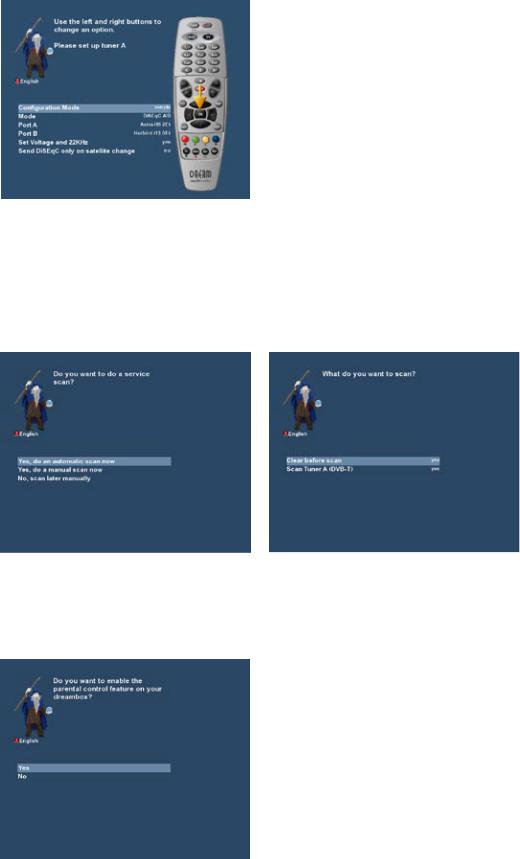
-16-
3.3 Tuner setup
Detailed information about the tuner setup can be found in chapter 11.1 DVB-S2 Tuner configuration.
3.4 Default services list/Service scan
Depending on your tuner configuration in the previous step, you might be offered to install default services lists. Otherwise you will be asked to perform a service scan. Detailed information about the service scan can be found in chapter 11.2 Automatic scan.
3.5 Parental Control
Refer to section 6.7 Parental control for further information about this feature.

-17-
Entering the pincode
Finalizing the basic setup
3.6 Network
The network wizard will assist you with the network setup of your Dreambox.
Press the OK-Button on your remote control to get to start the configuration.

-18-
Choose the desired network controller usning the Navigation-But- tons up/down and press the OK-Button to select.
Usually the standard setting (Use DHCP) should work if you have connected your Dreambox to a internet router. The DHCP-Server needed for this setting is most of the time activated by default on a router.
For further information please refer to chapter 10.5 Network.
Press the OK-Button on your remote control to get to activate the network device.
Activating the network
Answer “yes“ by pressing the OK-Button to finally activate the network device.
The activation process will take a short while.
Once the activation process is finished you will see the message depicted on the left.
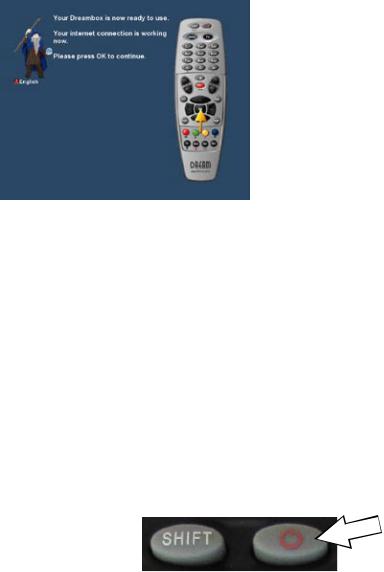
-19-
Finalizing the network wizard
You will see this screen once the activation process was successful. Otherwise you will get the chance to try it once again from the start.
4. Basic operation
4.1 Turning your Dreambox on and off
Use the Power-Button to turn your Dreambox on and off.
To put your Dreambox into Standby-Mode either press the Power-Button on your remote control or directly on your Dreambox.
Holding down the Power-Button on your remote control for three seconds will put your Dreambox into the Deep-Standby-Mode.
You can also put your Dreambox into Deep-Standby-Mode by using the OSD main menu. Choose the Option “Standby / Restart” in the OSD main menu and navigate to “Deep Standby” option afterwards.
Pressing the OK-Button will put your Dreambox into the Deep-Standby-Mode. All your settings will be saved now and your Dreambox goes into Deep-Standby-Mode afterwards (saves energy!).
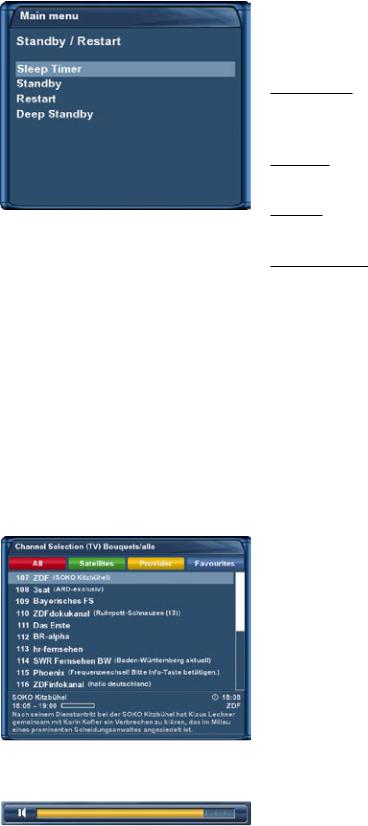
-20-
This is the Standby / Restart menu.
Navigate to the desired option and confirm by pressing the OK-
Button.
Sleep timer:
Put your Dreambox into Standby after a duration of time that can be chosen freely. For more info see chapter 9.
Standby:
Puts your Dreambox into Standby mode.
Restart:
Your Dreambox will be rebooted.
Deep Standby:
Puts your Dreambox into Deep-Standby-Mode.
4.2 Service selection
Pressing the Left/Right-Buttons on your Dreambox remote control will take you to the previous or next service.
Pressing the 0 on the Numeric-Keypad will enable you to skip back and forth between the two most recently watched services. This feature is quite useful during commercial breaks since it enables you to watch another channel and quickly check if your movies is back on.
Using the Navigation-Buttons left/right you can switch to the 20 last viewed services.
4.3 Changing channel using the service list
Pressing the Up/Down-Buttons on your remote control activates the service list.
Use the Navigation-Buttons up/down to select the desired service and press the OK-Button to change to the selected service.
4.4 Controlling the volume
The Volume +/- Buttons control the volume of the audio. Pressing + will make turn it up and pressing - will turn it down.
Pressing the MUTE-Button mutes the volume. A crossed speaker symbol will appear on the screen.

-21-
4.5 Changing the audio track
Pressing the AUDIO-Button in TV or Radio Mode will reveal the “Audio” menu of the selected service.
Use the Navigation-Buttons up and down to move to desired audio track. Press the OK-Button to select.
The contents of this menu will vary from service to service.
Press the red Options-Button to toggle AC3 downmix on and off.
See chapter 10.4 A/V Settings for further information.
4.6 Sub Services
The green dot in the Infobar appears if the selected station transmits sub services.
Pressing the green Options-Button in TV or Radio mode will reveal the sub services menu.
Use the Navigation-Buttons up and down to move to one of the sub services. Press the OK-Button to select.
4.7 TV/Radio switching
Pressing the RADIO-Button activates the RADIO-Mode. By pressing the TVor EXIT-Button you can quit the RADIO-Mode.
4.8 Teletext
Use the Text-Button to enter the Teletext and the Exit-Button to leave.
4.9 Subtitles
Press the Menu-Button to enter the main menu. Select “Subtitles” and press the OK-Button. A list with the available subtitles will show up. Use the Navigation-Buttons up and down to select a desired subtitle and press the OK-Button to activate.
The screenshot on the left shows you an example of how a subtitle looks.
To deactivate subtitles process as described previously, just select deactivate subtitles instead of a subtitle page.
Note: Keep in mind that not every station offers subtitles. If no subtitles are available, the subtitle list will stay empty.
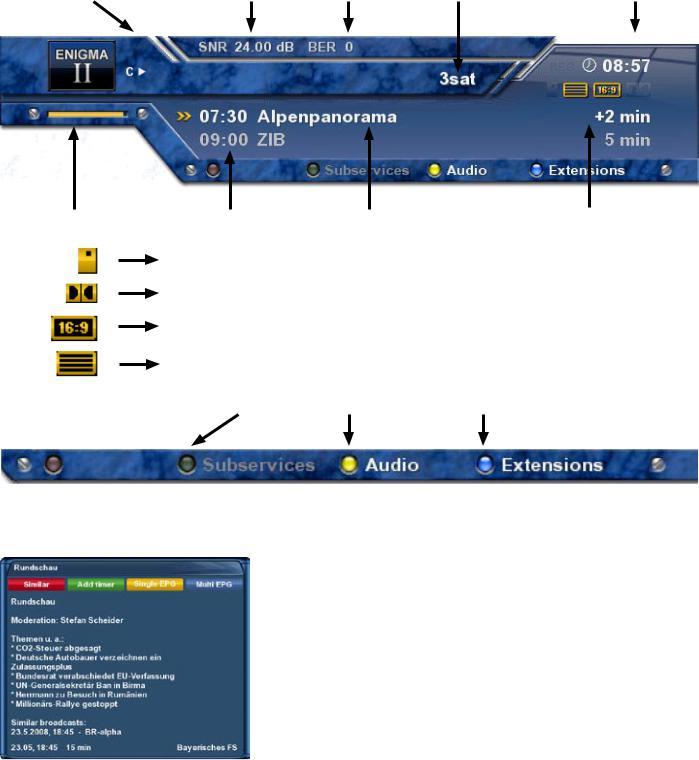
-22-
4.10 Infobar
The Infobar appears and disappears by pressing the OK-Button once, if no OSD menu is shown on your screen or when you change channels. The Infobar shows all necessary Information about the selected service.
active Tuner |
|
Signal level |
|
Error rate |
|
channel name |
|
Current time |
|
|
|
|
|
|
|
|
|
Progress bar |
|
Next Show |
|
Current show |
|
Remaining time |
|
|
|
|
|
|
|
Is highlighted yellow as soon as a show is broadcasted encrypted.
Is highlighted yellow as soon as a show is broadcasted in Dolby Digital.
Is highlighted yellow as soon as a show is broadcasted in 16:9 aspect ratio.
Is highlighted yellow as soon as a station transmits Teletext information.
Subservices |
|
Audio Options |
|
Extensions |
|
|
|
|
|
5. Electronic Program Guide - EPG
By pressing the INFO-Button in TV-Mode you are supplied with detailed information about the current show and by pressing the Right-Button afterwards about the next show.
Pressing the yellow Options-Button activates the “Channel-EPG” (See chapter 5.1) and pressing the blue Options-Button activates the “Multi-EPG“ (See chapter 5.2).
The Dreambox automatically searches for similar broadcasts in the background. If one or more similar broadcasts are found the label “Similar” will appear in the red window.
